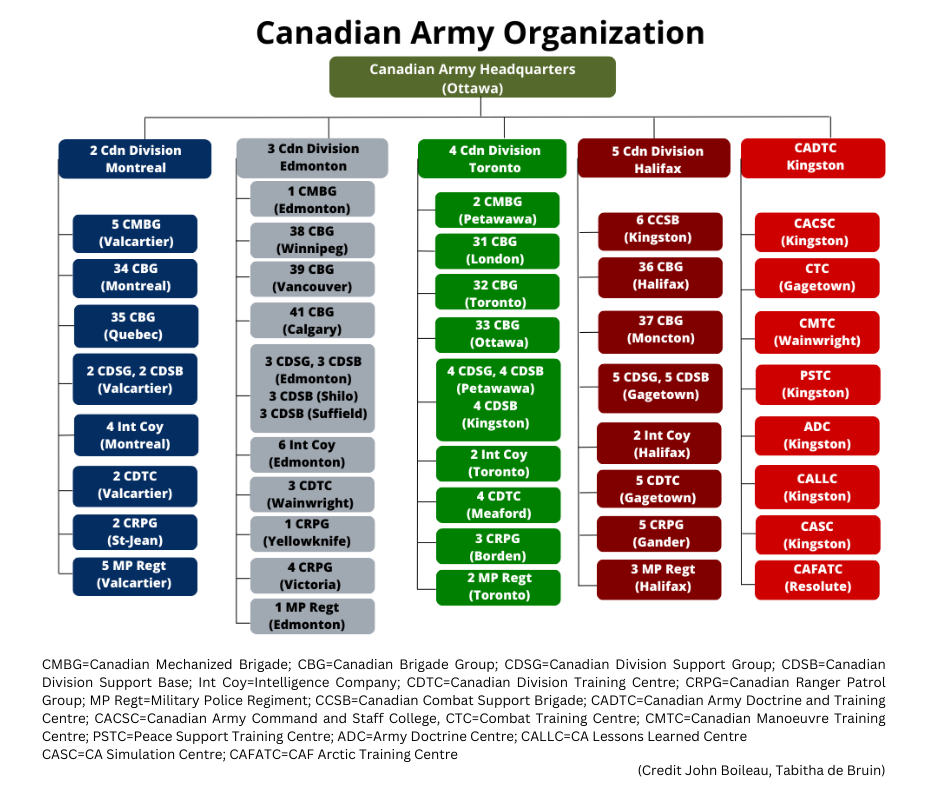Browse "Military"
-
Article
Canadian Army Meteorological Group
The Canadian Army Meteorological Group (CAMG) was a Second World War unit that provided meteorological data to artillery units. The CAMG was involved in key campaigns during the war in Italy and Northwest Europe. Meteorological information helped improve the accuracy of artillery fire, contributing to Allied victory in the war.
"https://d2ttikhf7xbzbs.cloudfront.net/CAMG/Meteorology-observer.jpg" // resources/views/front/categories/view.blade.php
https://d2ttikhf7xbzbs.cloudfront.net/CAMG/Meteorology-observer.jpg
-
Article
Canadian Army Organization
The Canadian Army is organized into four geographically based divisions, as well as a headquarters and a doctrine and training centre. The divisions include regular and reserve units. The head of the Canadian Army is a lieutenant-general; the current commander, Lieutenant-General Michael Wright, assumed that position on 12 July 2024. As of early 2024, the army comprised about 22,000 Regular Force soldiers, 20,000 Reservists, 5,000 Canadian Rangers and 3,500 civilian employees.
"https://d2ttikhf7xbzbs.cloudfront.net/CA-Organization-Chart-legend-rev-colours-1.png" // resources/views/front/categories/view.blade.php
https://d2ttikhf7xbzbs.cloudfront.net/CA-Organization-Chart-legend-rev-colours-1.png
-
Article
Canadian Aviation Corps
The Canadian Aviation Corps was formed in September 1914, immediately after the start of the First World War. The three-person, one-plane unit sailed to Britain with the First Canadian Contingent in early October 1914 but never saw active service. The CAC was disbanded in May 1915. Canada would not have a permanent air force until 1924 (see Royal Canadian Air Force).
"https://d2ttikhf7xbzbs.cloudfront.net/Aviation/Burgess-Dunne-floatplane.jpg" // resources/views/front/categories/view.blade.php
https://d2ttikhf7xbzbs.cloudfront.net/Aviation/Burgess-Dunne-floatplane.jpg
-
Article
Canadian Expeditionary Force
The Canadian Expeditionary Force was the army raised by Canada for service overseas in the First World War. About 630,000 Canadians enlisted between 1914 and 1918—most of them volunteers—as soldiers, nurses, doctors, and forestry and railway crews. More than 234,000 were killed or wounded in the war.
"https://d2ttikhf7xbzbs.cloudfront.net/media/media/73ffb06f-627d-4c89-ba46-f99a9ca67524.jpg" // resources/views/front/categories/view.blade.php
https://d2ttikhf7xbzbs.cloudfront.net/media/media/73ffb06f-627d-4c89-ba46-f99a9ca67524.jpg
-
Article
Canadian Forces Base Borden
Canadian Forces Base (CFB) Borden has always been primarily a training base for the Canadian Forces (CF). It is located 80 km northwest of Toronto, and was named after Sir Frederick Borden, Laurier's militia minister (1896-1911).
"https://d2ttikhf7xbzbs.cloudfront.net/The-Memory-Project/image/2016_original.jpg" // resources/views/front/categories/view.blade.php
https://d2ttikhf7xbzbs.cloudfront.net/The-Memory-Project/image/2016_original.jpg
-
Article
CFB Cornwallis (HMCS Cornwallis)
HMCS Cornwallis was established as a training centre for members of the Royal Canadian Navy (RCN) and the Women’s Royal Canadian Naval Service (WRCNS) during the Second World War. Although it closed in 1946, it resumed operations as a training centre in 1949. After unification of the Canadian armed forces in 1968, it was renamed CFB Cornwallis and became the English-language training centre for recruits from all elements (sea, land and air). The base was decommissioned in 1995. More than 500,000 members of the Canadian armed forces trained at HMCS/CFB Cornwallis.
"https://d2ttikhf7xbzbs.cloudfront.net/CFBCornwallis/HMCS-Cornwallis-8July1943.jpg" // resources/views/front/categories/view.blade.php
https://d2ttikhf7xbzbs.cloudfront.net/CFBCornwallis/HMCS-Cornwallis-8July1943.jpg
-
Article
Canadian Forces Base Gagetown
Canadian Forces Base Gagetown (or CFB Gagetown) functions primarily as the combat-training centre for the Canadian Army and comprises 111,000 hectares between Fredericton and Saint John, New Brunswick, west of the Saint John River.
"https://d2ttikhf7xbzbs.cloudfront.net/Black_Watch_Gagetown.jpg" // resources/views/front/categories/view.blade.php
https://d2ttikhf7xbzbs.cloudfront.net/Black_Watch_Gagetown.jpg
-
Article
Canadian Forces Base Petawawa
Renamed Canadian Forces Base Petawawa in 1968, the base has a total population of 5,000. As one of Canada's busiest operational bases, it is economically important to the adjacent town of Petawawa and nearby Pembroke.
"https://d2ttikhf7xbzbs.cloudfront.net/media/media/098aa086-dfcf-4c65-a548-365e130e24e4.jpg" // resources/views/front/categories/view.blade.php
https://d2ttikhf7xbzbs.cloudfront.net/media/media/098aa086-dfcf-4c65-a548-365e130e24e4.jpg
-
Article
Canadian Forces Base Shilo
Shilo, Canadian Forces Base (CFB), is located on the western boundary of Manitoba's Spruce Woods Provincial Forest, 195 km west of Winnipeg and 25 km east of Brandon. A portion of the forest is leased to the federal government for the Shilo military reserve. The base is part of Land Force Western Area (LFWA), which was established in 1991, with its headquarters in Edmonton.
"https://d2ttikhf7xbzbs.cloudfront.net/The-Memory-Project/image/10280_original.jpg" // resources/views/front/categories/view.blade.php
https://d2ttikhf7xbzbs.cloudfront.net/The-Memory-Project/image/10280_original.jpg
-
Article
Canadian Forces Base Trenton
8 Wing/Canadian Forces Base Trenton is located 167 km east of Toronto on Lake Ontario's Bay of Quinte. Begun in 1929 on 384 ha of flat farmland adjacent to the town of Trenton.
"https://d2ttikhf7xbzbs.cloudfront.net/media/media/8377e866-518b-4c25-9a3f-72d2f2cca799.jpg" // resources/views/front/categories/view.blade.php
https://d2ttikhf7xbzbs.cloudfront.net/media/media/8377e866-518b-4c25-9a3f-72d2f2cca799.jpg
-
Article
Canadian Forces Base Valcartier
Canadian Forces Base (CFB) Valcartier is one of the oldest military training areas in Canada. Located a few kilometres north of Quebec City, it was founded as Camp Valcartier just before the First World War. During the war, it was the primary training base for the First Canadian Contingent before it departed for overseas service. Today it is one of the Canadian Army’s major bases and is known as 2nd Canadian Division Support Base Valcartier.
"https://development.thecanadianencyclopedia.ca/images/tce_placeholder.jpg?v=e9dca980c9bdb3aa11e832e7ea94f5d9" // resources/views/front/categories/view.blade.php
https://development.thecanadianencyclopedia.ca/images/tce_placeholder.jpg?v=e9dca980c9bdb3aa11e832e7ea94f5d9
-
Article
Canadian Forces Bases
Canadian Forces Bases (CFBs) are the homes of the operational units of the Canadian Armed Forces. Bases also provide housing and support services to Armed Forces members and their families. Canadian Forces Stations (CFSs) are smaller than bases and usually have minor operational units, but little or no support function.
"https://d2ttikhf7xbzbs.cloudfront.net/media/media/e137427f-a041-4fb2-b2f1-378549121ded.jpg" // resources/views/front/categories/view.blade.php
https://d2ttikhf7xbzbs.cloudfront.net/media/media/e137427f-a041-4fb2-b2f1-378549121ded.jpg
-
Article
Canadian Forces in Europe During the Cold War
During the Cold War, Canada stationed army and air force units abroad for the first time during peacetime. Soldiers and airmen began to arrive in the early 1950s, shortly after the Cold War began, and remained until 1993, after it ended. In total, more than 100,000 Canadian military personnel served in France and West Germany in that period.
"https://d2ttikhf7xbzbs.cloudfront.net/media/media/e011169341-v8.jpg" // resources/views/front/categories/view.blade.php
https://d2ttikhf7xbzbs.cloudfront.net/media/media/e011169341-v8.jpg
-
Article
Canadian Forces Logistics Training Centre Music Division
The Canadian Forces School of Music was established as the Royal Canadian Navy School of Music (École de musique de la Marine royale du Canada) in Esquimalt, BC, in 1954 to provide musicians for Canadian Navy bands. In 1961, it expanded to accommodate trainees for Army and Air Force bands. With the unification of the Armed Forces in 1968, it became the Canadian Forces School of Music (CFSM). Now known as the Canadian Forces Logistics Training Centre Music Division, the school has been located at CFB Borden near Barrie, Ontario, since 1987.
"https://development.thecanadianencyclopedia.ca/images/tce_placeholder.jpg?v=e9dca980c9bdb3aa11e832e7ea94f5d9" // resources/views/front/categories/view.blade.php
https://development.thecanadianencyclopedia.ca/images/tce_placeholder.jpg?v=e9dca980c9bdb3aa11e832e7ea94f5d9
-
Article
Canadian Grenadier Guards Band
Canadian Grenadier Guards Band. Regimental band founded 26 Apr 1913 in Montreal by J.-J. Gagnier, who became its conductor. At that time it consisted of about 40 players, half of whom were professionals, including six members of the Gagnier family. Formed at the request of F.S.
"https://development.thecanadianencyclopedia.ca/images/tce_placeholder.jpg?v=e9dca980c9bdb3aa11e832e7ea94f5d9" // resources/views/front/categories/view.blade.php
https://development.thecanadianencyclopedia.ca/images/tce_placeholder.jpg?v=e9dca980c9bdb3aa11e832e7ea94f5d9
